Vtuber
1. Introduction
When we first got introduced to this group project, we immediately knew that the four of us would be able to work together perfectly. After class, we made a group chat on Discord, so we could easily communicate with each other. Every week we held meetings to discuss our project, to divide the tasks and so on. After several idea exchanges related to “Japanese Culture” we decided to do more research on the topic of “VTubers”.
First of all, what is a VTuber? VTuber is an acronym that stands for Virtual YouTuber (とあるVtuber好きの備忘録, n.d.). It’s a general term for characters with an avatar drawn in 2DCG or 3DCG who post and broadcast videos on the internet and media, and have mainly been active since the end of 2017, or distributors who post videos and broadcast live using them (Wikipedia 2021). The start of the hype of VTubers can be traced back to the first created VTuber, Kizuna Ai.

Referring to herself as a Virtual YouTuber, she reached 1 million subscribers on her YouTube channel in just one year. When this news was featured on the front page of Yahoo News, the entire VTuber genre gained attention explosively (とあるVtuber好きの備忘録, n.d.). Over the years of 2017 and 2018, the number of VTubers has increased significantly. Since there are no limits to what a VTuber can be, they are able to appeal to a very broad range of individuals. Some play video games, some read stories, some give product introductions… It has charms that cannot be expressed in a single word. Recently, it’s become a common occurrence for companies to invest in VTubers, to use their popularity for promoting their own products and to improve their image in the public eye.(けいろー 2021). One of these famous companies that invests in VTubers is Hololive Production. Hololive is an agency for VTubers that has the same concept as a talent agency (He 2021). The agency is also one of the reasons for the rising popularity VTubers are gaining. You may think that VTubers are different from normal human YouTubers, but actually they act and sound just like them since they get voiced by humans, called ‘Nakanohito’ (Lufkin 2018). The agency thus not only recruit VTubers, but also ‘Nakanohito’ and other staff members.

But why are they so popular, what makes them able to appeal to a large number of people? We have conducted a literature study to find out more about the characteristics. VTubers can be called anthropomorphic beings, in other words they are like humans. (Dazon 2020). They can be expressive like humans due to the help of advanced technologies that can capture lots of facial movements. With the use of Motion Capture, movements can become more realistic. (SHINchan@MaDeLa 2018). When looking at their appearance, most of the VTubers follow some kind of ‘formula’. Since most VTubers originate from Japan, it is common that they look cute, girly, have high-pitched voices and radiate kawaii. This impression you get when watching VTubers is called Moe Anthropomorphism. This is a feeling of cuteness that a character can stimulate (Dazon 2020). Because most of them have an anime-styled avatar, they attract many viewers from the Otaku subculture. The specially-designed persona for their YouTube channel was also one of the reasons behind their popularity. (Zhicong et al. 2021). Aside from their appearance, the relatable chat content they share with their viewers is one of their appeals. AI live in a CG World, so when they share relatable chats with their viewers, they can provide a world where people are able to escape from reality (Soba 2020).
Before we started with our quantitative research to find the real reasons for their popularity, we hypothesized that the main reason for VTubers’ popularity is their cute anime-styled avatar.
We have chosen to further analyze the topic of ‘VTubers’ because we thought it was something popular in the eastern world but not in the western world. Our prediction seems to be accurate on that since we didn’t find a lot of papers or research articles about VTubers. We had many other ideas related to Japanese culture such as anime, manga, Pokémon, noodles and so on, but since these topics were discussed last year we decided to go with VTubers.
2. Quantitative research
Working procedure
In order to find out what makes or breaks a VTuber’s popularity, we tried to accumulate a number of character traits, physical traits and otherwise distinctive features. We manually went through all of our source material and assigned these traits to a spreadsheet table, keeping track of the amount of occurrences per source, the amount of sources that mention said trait, the names of those sources, the names of any VTubers associated with these traits and which category of characteristics the traits belong in. We decided on the following five categories: Positive Outer Traits, Negative Outer Traits, Positive Inner Traits, Negative Inner Traits and Other Traits. We ended up with 97 unique traits, divided over a total of 26 different sources. After a first effort to accumulate these traits, we compared the phrasing to make sure we did not have any similar traits under different names. We then conducted another literature study to verify whether the sources we used were still valid and whether no other sources had since come available for us to include in our research.

When the data were final and ready to be put to use, a number of operations were executed on them. First, they were grouped into tables separately per category, as well as accumulated in one large dataset to find results concerning the entire dataset. This left us with six tables. For each trait in each of these six tables, the following calculations were made:
- A count of how many sources mention the trait.
- The result of 1. divided by the amount of total sources, to result in the percentage of sources that mention the trait.
- A count of the amount of times the trait was mentioned over all of the sources.
- The result of 3. divided by a count of every mention of any trait, to result in the percentage of how often the trait appeared.
- Two weights were assigned to represent the importance of sources and occurrences respectively. Sources were given the number 67 as a weight, and occurrences were given the number 33. Then we multiplied the percentage of 2. by 67 and added to it the percentage of 4. multiplied by 33. This leaves us with a somewhat abstract number, the weighted average.
- To make this weighted average into a comprehensible measure, we divided the weighted average for each trait by the total sum of all the weighted averages, giving us a final percentage that represents the importance of each trait, relative to that of the other traits.
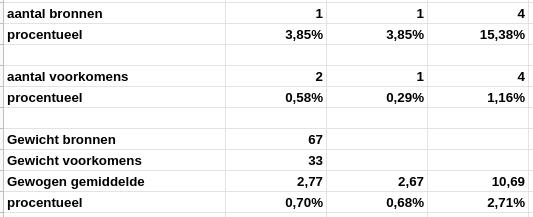
For each of the six subsets, this enabled us to provide tables showing the importance in a number of different contexts. Many remarkable observations can be made, so we have chosen to visualize our data to make as much of it as possible accessible and easy to follow along.
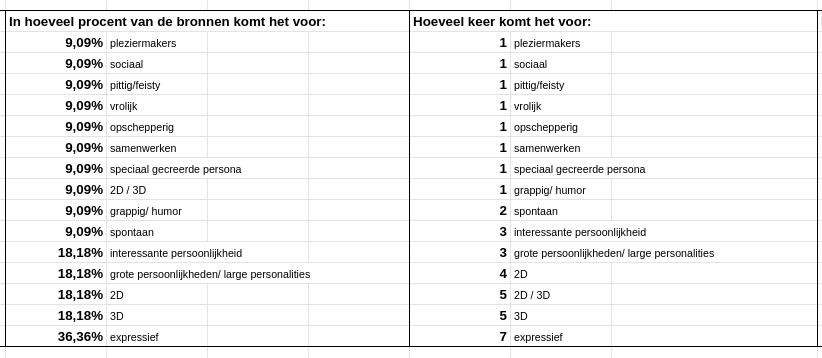
Remarks about the results
The way we conducted our quantitative research allows for a myriad of interpretations, as the possibilities of the resulting datasets are endless. Therefore, the following is by no means a complete report of every finding there is to be made about the research results. It simply provides an overview of some aspects we thought were worth mentioning in relation to the focus we decided to put on our work.
When it comes to the categories of negative traits, both Negative Outer Traits and Negative Inner Traits only contain one trait, “lack of realism” and “lack of authenticity” respectively. “Lack of realism” was mentioned once in one source, and “lack of authenticity” was mentioned twice over two sources. This leads to some questions about weaknesses of the research, which will be further discussed later.
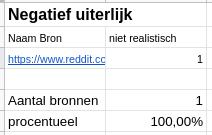
10 of the 12 sources used in the table of Positive Outer Traits mention the “Anime-style avatar” trait, which is five times the amount of sources of the second most prominent traits. When it comes to the total number of mentions within this category, “anime-style avatar” has 20 occurrences, which combined with the 12 occurrences of second place trait “avatar” amounts to 32 of the 65 total mentions. However, in the weighted average, “avatar” fails to make the top 3, which instead becomes “anime-style avatar” (28,20%), “cute” (5,86%) and “female” (5,64%).
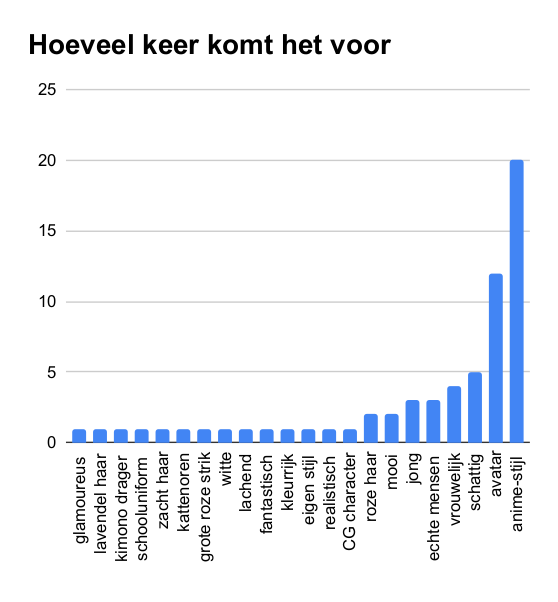
As for Positive Inner Traits, 4 sources mention “expressive”, putting it in first place. The other 4 traits in the top 5 only get mentioned in half of that, 2 sources each. “Expressive” also takes the cake in occurrences, even though it only has 7 of them, indicating that this category was relatively small. This is also clear when looking at the overarching complete dataset, where “expressive” is the only inner trait to make the top 10 in weighted average importance.
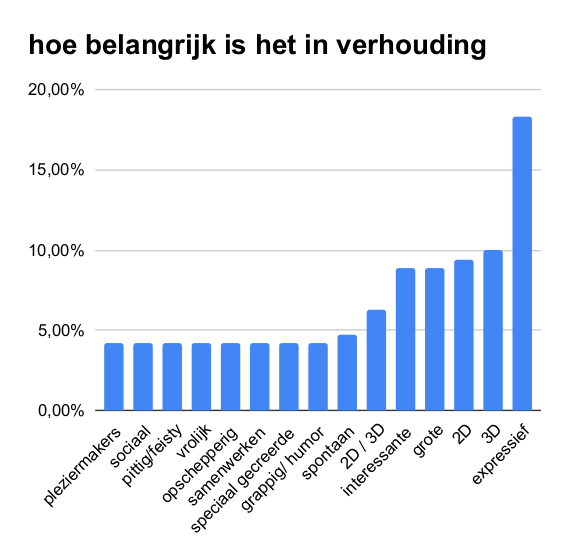
“Interaction with fans” is the big winner in the category of Other Traits, reigning supreme in every list. This means it was mentioned the most, mentioned in the most sources, and as a logical result of that, had the largest weighted importance. This is even more remarkable considering the Other Traits category is the largest one aside from the total dataset, with 58 unique traits, being mentioned a total of 241 times over 20 sources. The first six traits account for 106 of those mentions, while the other 135 mentions are divided over 52 traits.
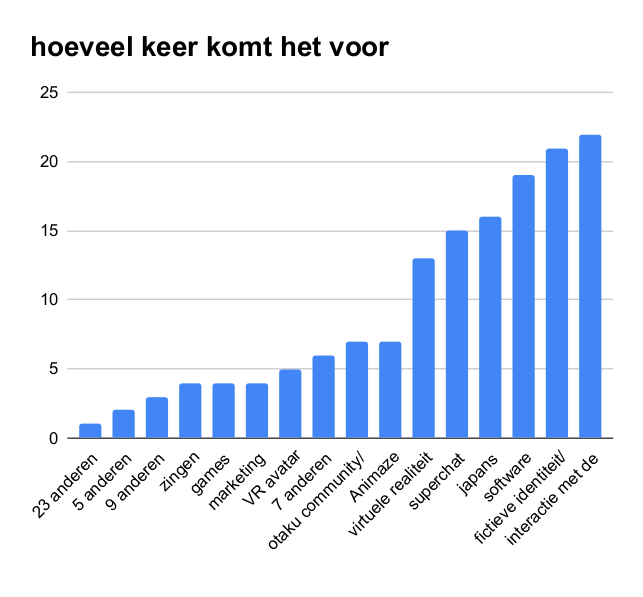
Finally, let’s take a look at the complete dataset, including every source and every trait. Our top 3 traits are familiar ones, being “Anime-style avatar”, “interaction with fans” and “expressive”. Interestingly, these three all come from different categories of traits. “Anime-style avatar” is mentioned in over a third of all sources, followed by “interaction with fans” in almost a quarter of all sources. When it comes to absolute number of occurrences, “fictional identity” is a remarkable second place, being mentioned 21 times, yet only taking 9th place in relative importance overall. The top spot here is again held by “interaction with fans” with 22 occurrences. In relative importance overall, we can see that 48 out of the 97 traits have the same weight of 0,68%, making up the entire bottom half of the data.
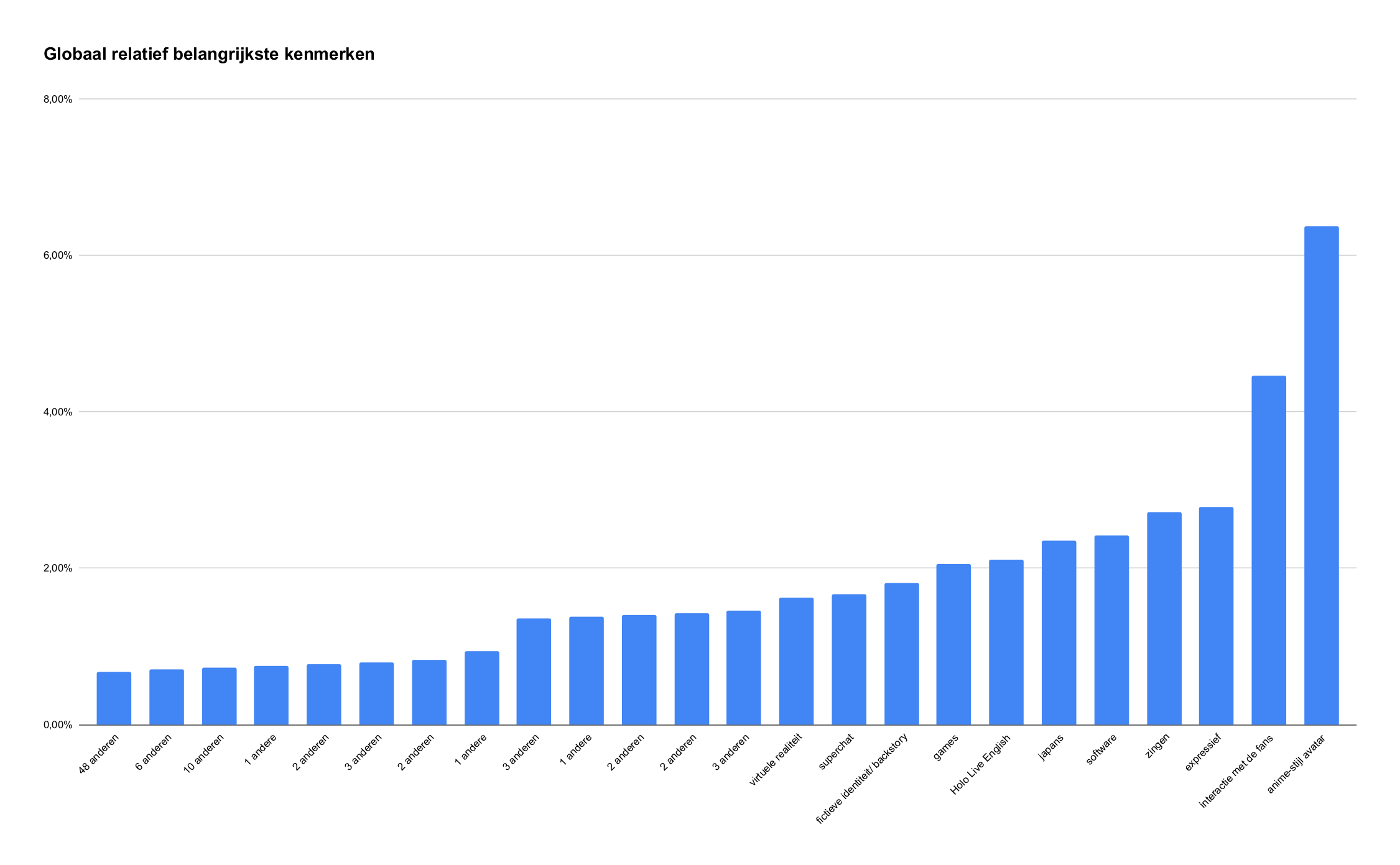
Conclusion of quantitative research
Many findings can be made based on the research we have conducted over the past few weeks. We have made a selection of some of the concluding thoughts and results we have drawn from that, which, in short, were as follows.
There were very little mentions of negative traits about VTubers in the sources we used. The Positive Outer Traits category is dominated by the “anime-style avatar” trait, which also ends up being the relatively most important trait overall. In the small category of Positive Inner Traits, “expressive” is almost twice as important as the second-place holder, and the only trait to still appear high on the leaderboard of relative importance in the end. The largest separate category was Other Traits, with 241 of the total 346 occurrences, featuring 20 of the 26 used sources. The leader of this category, “interaction with fans” only takes second place in relative importance overall though, losing to Positive Outer Trait “anime-style avatar” with a significant difference in weight. Half of all traits were only worth 0,68% of the total importance, basically occurring only once in only one source.
Remarks about the working procedure
Lastly for the quantitative part of this article, we would like to point out some difficulties in the procedure of our research. A lot of time and effort have gone into this project, and the results we offered are presented with confidence, however, limitations in time and resources resulted in a few areas where improvements may be made.
The lack of negative traits might be indicative of a bias in the sources we used, a bias in the searching procedure of the traits within the sources, or a lack of critical assessment of the sources we decided to use. We were also rather limited in the sources we could find, access and utilise for this research project. A lack of technological knowhow resulted in some problems trying to analyze web pages such as fora and social media posts, which often have a system with ‘likes’ or ‘upvotes’, which we did not know how to correctly implement into the data we collected.
The data was collected manually, also because we lack the technical knowledge to automate this process. This means it is susceptible to human error, although we have thoroughly tried to account for this and keep an eye on the quality of our selection process.
With this, we have gathered the required conceptual building blocks to start thinking about what an ideal VTuber might look like, a process we have tried to concretize in the following section of the article.
3. How can you become a VTuber?
We’ve explained what a VTuber is, and what makes a VTuber a popular VTuber. But, how can you become one yourself? We will demonstrate 3 software programs and 3 apps that you could use to create your own virtual avatar.
Software
There are a number of different software that you can use to become a VTuber, from simple ones, to more complex ones.
We will focus on 3 software that are easy and intuitive to use for regular people without much of a technological background.
Facerig
With this software, you can become a VTuber straight away since there are already a few avatars available. The software costs €14,99, and you can upgrade to a pro version for €59,99. This software is available on Steam, only downloadable on Windows.
VTube Studio
On VTube Studio, you would have to make your own avatar design on Live2D and import it so you can make the avatar move. There are trial models at first which you can use to try the software out, but you can’t use them as your avatar to become a VTuber. This software is free and available on Steam for MacOS and Windows.
Hitogata
On this free software, you can customize and move your own VTuber. This is an easy and excellent way to start as a VTuber. This software is only downloadable on Windows.
Apps
Like software, there are plenty of apps that you can use to make and move your avatar. We will also discuss 3 easy apps.
Vカツ (VKatsu)
On this free app, you can make and customize your own avatar, and you can move their faces with face tracking with the camera of a smartphone. This app is available for iOS, and also as software for a computer, which you can download on Steam (MacOS and Windows).
ホロライブ (Hololive)
You can only change the character’s hair color and eye color on this free app. This app is available on iOS and Android.
トピア (Topia)
This is also a free app where you can make your 3D avatar and go live, also available on iOS.
Experimenting with software and apps
For our paper, we chose one software and one app to try out, namely VTube Studio and Vカツ (VKatsu). The reason why we tried VTube Studio, which is quite limited, instead of other software such as Hitogata, is because we lack the technological necessities to run the other programs. In other words, we don’t use Windows.
First, we wanted to try VTube Studio. It was easy and free to download from Steam. We then discovered that you can’t create your own avatar with this software, and that you have to import one from Live2D. There are 5 trial models, so you can try and see how you could move your own avatar to record a video or stream it live. You can also change the background to a fitting scenario or simply a color. To control the facial expressions and move their bodies, you have to use your webcam. The face tracking, which you’re able to tweak a number of details for, is used to make the avatar blink, smile, open their mouth, etc.
After that, we downloaded Vカツ (VKatsu) on the App Store. First, we quickly looked into all the possibilities of customizing the avatar, from hair to clothes. Then, we created our own avatar, 春川ベル (Harukawa Bell). Finally, we looked at how smooth the face tracking mode was. The facial expressions were quite accurate. You can directly go live on the apps Mirrativ and OPENREC.tv, but you could also just connect your smartphone to a computer to go live on YouTube, or record the screen of your smartphone to later put out as a video. This app was amazingly easy to use to make an avatar and the face tracking mode was very user friendly.
You can see the entire process of experimenting with the software/app and making our avatar on YouTube: ‘VTuber experimenting with VTube Studio and Vカツ (VKatsu) (WPC)’ (https://youtu.be/y-EHG5EtI9o)).
4. Conclusion
Vtubers (Virtual Youtubers) are a fairly recent phenomenon, that in these last years rapidly grew in numbers and in popularity. Not only do these online entertainers sell well in the East, they also started to break through in the Western market.
We’ve tried to research the reason behind the popularity of these Vtubers. Is there an exact formula for a popular Vtuber or is it all coincidence?
Our research began with collecting as many different types of (online) sources as possible. After gathering an entire library, we went through each source, summarizing them and writing down the important keywords and all the characteristics related to Vtubers we could find. These characteristics were placed in a table, together with the amount of times they were named in each source and the amount of times they were mentioned across the different sources. After applying mathematical formulas, our quantitative research resulted in an overview of the most common and least used characteristics.
At the start of our analysis, we’ve hypothesised that the cute anime-style exterior of the Vtuber might have something to do with the popularity of one. Our results show our hypothesis was right, with ‘anime-style avatar’ as one of the top 3 most important traits of a successful Vtuber. On top of that, the expressiveness of the Virtual Youtuber and the interaction between the Youtuber and the fans also play a significant role.
Based on the results of our quantitative research, we’ve tried to apply our results to reality, by making our own Vtuber. Nowadays, there are many free apps where you can easily make a professional-looking Vtuber for free. After researching the different types of available software and playing around with them for a bit, our avatar, a cute-looking girl with pink hair and a large chest named Harukawa Bell (春川ベル) came into existence. Even though we don’t know how she would do in ‘the real world’ among the other avatars, she at least looks promising and very well made.
For our research, we had to rely on the (mainly) non-academic sources that we’ve gathered from the web. Since Vtubers are a modern and brand new concept, there hasn’t been much professional research conducted about them. Even though we used many different types of sources, collected from various search engines, there was a clear lack of negative traits in our list of characteristics. Is that because we didn’t deliberately search for negative traits? Or is it because there are simply no sources revolving around these negative traits? For future research, it might be useful to keep these (and the lack of) negative traits in mind.
We’ve started this project with a vague understanding of what a Vtuber was and a lot of motivation to learn more about this modern medium of Japanese popular culture. We’ve theorised that the appearance of the avatar might contribute to the popularity of the Vtuber, and our research has proven that. It also has shown that the expressiveness of the avatar and the interaction between the Vtuber and the fans are important as well. Making your own Vtuber avatar is made very accessible and easy thanks to the various free software that are available on the web, but creating a professional-looking avatar still takes a lot of work. In the end, we’re satisfied with our research and we hope that this may inspire others to also explore this new world of Virtual Youtubers.
5. Bibliography
Introduction
663290_MT_ALL.pdf. (n.d.).
Bashir, D. (2020, November 27). Up Close And Personal With Valryia Starfyre, One of Malaysia’s Most Popular VTubers. IGN Southeast Asia. https://sea.ign.com/twitch/166549/news/up-close-and-personal-with-valryia-starfyre-one-of-malaysias-most-popular-vtubers
Bhattacharya, S., & Davis, R. (2019, August 21). Japan’s Digital Pop Stars Blur Line Between Virtual and Reality --- “VTubers” act as live performers, spokespeople and surrogate children. Wall Street Journal, Eastern Edition, A.1. https://search.proquest.com/docview/2276725064/citation/341521C97324DD1PQ/1
Chen, J. (2020, November 30). The Vtuber takeover of 2020. Polygon. https://www.polygon.com/2020/11/30/21726800/hololive-vtuber-projekt-melody-kizuna-ai-calliope-mori-vshojo-youtube-earnings
Dazon, L. (2020, March 16). Virtual Youtubers - What’s the appeal? - Quench Magazine. Quench. https://cardiffstudentmedia.co.uk/quench/culture/virtual-youtubers-whats-the-appeal/
Final_thesis_Xin_Zhou (1).pdf. (n.d.).
index/frequentlyaskedquestions - VirtualYoutubers. (n.d.). Reddit. Retrieved April 5, 2021, from https://www.reddit.com/r/VirtualYoutubers/wiki/index/frequentlyaskedquestions
Lu, Z., Shen, C., Li, J., Shen, H., & Wigdor, D. (2021). More Kawaii than a Real-Person Live Streamer: Understanding How the Otaku Community Engages with and Perceives Virtual YouTubers (p. 14). CHI. https://www.cs.cityu.edu.hk/~zhiconlu/assets/pdf/CHI2021Vtuber.pdf
Lufkin, B. (2018, October 3). The virtual vloggers taking over YouTube - BBC Worklife. BBC Worklife. https://www.bbc.com/worklife/article/20181002-the-virtual-vloggers-taking-over-youtube
Nico Nico pedia. (n.d.). バーチャルYouTuber. In Nico Nico pedia. https://dic.nicovideo.jp/a/%E3%83%90%E3%83%BC%E3%83%81%E3%83%A3%E3%83%AByoutuber
Puspitaningrum, D. R., & Prasetio, A. (2019). Fenomena “Virtual Youtuber” Kizuna Ai di Kalangan Penggemar Budaya Populer Jepang di Indonesia. Mediator: Jurnal Komunikasi, 12(2), 128–140. https://doi.org/10.29313/mediator.v12i2.4758
Shirai, A. (2019). REALITY: broadcast your virtual beings from everywhere. ACM SIGGRAPH 2019 Appy Hour, 1–2. https://doi.org/10.1145/3305365.3329727
Soba, C. (2020, November 8). What is a VTuber? A look at the wonderful world of Virtual YouTubers. Ginx.Tv. https://www.ginx.tv/en/streams/what-is-a-vtuber-a-look-at-the-wonderful-world-of-virutal-youtubers
Virtual YouTuber. (2021). In Wikipedia. https://en.wikipedia.org/w/index.php?title=Virtual_YouTuber&oldid=1015879462
Virtual YouTuber Wiki. (n.d.). Retrieved April 5, 2021, from https://virtualyoutuber.fandom.com/wiki/Virtual_YouTuber_Wiki
Vtuber Insight. (n.d.). Retrieved April 5, 2021, from https://vtuber-insight.com/
VTuber Ranking List. (n.d.). VTuberランキング. https://virtual-youtuber.userlocal.jp/document/ranking
Vtubers: why do these streamers look like anime characters and why are they popular? | Clocked. (2020, September 23). Happy Mag. https://happymag.tv/why-vtubers-are-so-popular/
【Vチューバーとは?】やり方や仕組み、おすすめVtuberまとめ. (n.d.). とあるVtuber好きの備忘録. Retrieved April 7, 2021, from https://vtuber-love.com/vtuber/
Vチューバーとユーチューバーの違いを紹介. (n.d.). Wondershare. Retrieved April 7, 2021, from https://filmora.wondershare.jp/vtuber/difference-between-vtuber-and-youtuber.html
You know that at all! ? 3 reasons why Vtuber is so popular in Japan. (n.d.). Retrieved April 5, 2021, from https://mangadejapan.com/articles/detail/847
YouTube Culture & Trends Report: VTubers - YouTube. (n.d.). Retrieved April 5, 2021, from https://www.youtube.com/watch?v=1endAJC_CC8
バーチャルYouTuber. (2021). In Wikipedia. https://ja.wikipedia.org/w/index.php?title=%E3%83%90%E3%83%BC%E3%83%81%E3%83%A3%E3%83%ABYouTuber&oldid=82788630
バーチャルYouTuber(VTuber)とは?今更聞けないキホンの解説! | 【しむぐらし】BIGLOBEモバイル. (2021, March 9). 【しむぐらし】格安SIMでちょっといい暮らし | BIGLOBEモバイル. https://join.biglobe.ne.jp/mobile/sim/gurashi/vtuber/
バーチャルYouTuberの人数が1万3000人突破、人気1位はファン数286万人のキズナアイ(TechCrunch Japan). (n.d.). Yahoo!ニュース. Retrieved April 7, 2021, from https://news.yahoo.co.jp/articles/1946906317dda9b704ce4acd3378e9b3264282c5
ピクシブ百科事典. (n.d.). バーチャルYouTuber. In ピクシブ百科事典. https://dic.pixiv.net/a/%E3%83%90%E3%83%BC%E3%83%81%E3%83%A3%E3%83%ABYouTuber
三省堂 辞書を編む人が選ぶ「今年の新語2018」. (n.d.). Retrieved April 5, 2021, from https://dictionary.sanseido-publ.co.jp/topic/shingo2018/
日本のVTuber「桐生ココ」スパチャ総額1億5千万円で2020年の世界1位 激増のYouTube“投げ銭”文化(KAI-YOU.net). (n.d.). Yahoo!ニュース. Retrieved April 7, 2021, from https://news.yahoo.co.jp/articles/d62f6db0b24a97f1b4828f3ba9a705daf5d7781b
Quantitative research
663290_MT_ALL.pdf. (n.d.).
Bashir, D. (2020, November 27). Up Close And Personal With Valryia Starfyre, One of Malaysia’s Most Popular VTubers. IGN Southeast Asia. https://sea.ign.com/twitch/166549/news/up-close-and-personal-with-valryia-starfyre-one-of-malaysias-most-popular-vtubers
Bhattacharya, S., & Davis, R. (2019, August 21). Japan’s Digital Pop Stars Blur Line Between Virtual and Reality --- “VTubers” act as live performers, spokespeople and surrogate children. Wall Street Journal, Eastern Edition, A.1. https://search.proquest.com/docview/2276725064/citation/341521C97324DD1PQ/1
Bredikhina, L., Kameoka, T., Shimbo, S., & Shirai, A. (2020). Avatar Driven VR Society Trends in Japan. 2020 IEEE Conference on Virtual Reality and 3D User Interfaces Abstracts and Workshops (VRW), 497–503. https://doi.org/10.1109/VRW50115.2020.00103
Chen, J. (2020, November 30). The Vtuber takeover of 2020. Polygon. https://www.polygon.com/2020/11/30/21726800/hololive-vtuber-projekt-melody-kizuna-ai-calliope-mori-vshojo-youtube-earnings
Dazon, L. (2020, March 16). Virtual Youtubers - What’s the appeal? - Quench Magazine. Quench. https://cardiffstudentmedia.co.uk/quench/culture/virtual-youtubers-whats-the-appeal/
Final_thesis_Xin_Zhou (1).pdf. (n.d.).
index/frequentlyaskedquestions - VirtualYoutubers. (n.d.). Reddit. Retrieved April 5, 2021, from https://www.reddit.com/r/VirtualYoutubers/wiki/index/frequentlyaskedquestions
Lu, Z., Shen, C., Li, J., Shen, H., & Wigdor, D. (2021). More Kawaii than a Real-Person Live Streamer: Understanding How the Otaku Community Engages with and Perceives Virtual YouTubers (p. 14). CHI. https://www.cs.cityu.edu.hk/~zhiconlu/assets/pdf/CHI2021Vtuber.pdf
Lufkin, B. (2018, October 3). The virtual vloggers taking over YouTube - BBC Worklife. BBC Worklife. https://www.bbc.com/worklife/article/20181002-the-virtual-vloggers-taking-over-youtube
Puspitaningrum, D. R., & Prasetio, A. (2019). Fenomena “Virtual Youtuber” Kizuna Ai di Kalangan Penggemar Budaya Populer Jepang di Indonesia. Mediator: Jurnal Komunikasi, 12(2), 128–140. https://doi.org/10.29313/mediator.v12i2.4758
r/VirtualYoutubers - What do you like about VTubers? (n.d.). Reddit. Retrieved April 27, 2021, from https://www.reddit.com/r/VirtualYoutubers/comments/el5d0t/what_do_you_like_about_vtubers/
r/VirtualYoutubers - What is the appeal of Vtubers over regular streamers? (n.d.). Reddit. Retrieved April 5, 2021, from https://www.reddit.com/r/VirtualYoutubers/comments/hcx9kn/what_is_the_appeal_of_vtubers_over_regular/
r/VirtualYoutubers - Why do you watch Vtubers? (n.d.). Reddit. Retrieved April 27, 2021, from https://www.reddit.com/r/VirtualYoutubers/comments/kaz9n4/why_do_you_watch_vtubers/
Shirai, A. (2019). REALITY: broadcast your virtual beings from everywhere. ACM SIGGRAPH 2019 Appy Hour, 1–2. https://doi.org/10.1145/3305365.3329727
Soba, C. (2020, November 8). What is a VTuber? A look at the wonderful world of Virtual YouTubers. Ginx.Tv. https://www.ginx.tv/en/streams/what-is-a-vtuber-a-look-at-the-wonderful-world-of-virutal-youtubers
Virtual YouTuber. (2021). In Wikipedia. https://en.wikipedia.org/w/index.php?title=Virtual_YouTuber&oldid=1015879462
Virtual YouTuber Wiki. (n.d.). Retrieved April 5, 2021, from https://virtualyoutuber.fandom.com/wiki/Virtual_YouTuber_Wiki
Vtuber Insight. (n.d.). Retrieved April 5, 2021, from https://vtuber-insight.com/
VTuber“Mori Calliope”、初の全国流通となる2nd EP『Your Mori.』リリース(CDジャーナル). (n.d.). Yahoo!ニュース. Retrieved April 7, 2021, from https://news.yahoo.co.jp/articles/f6cd174d4ca750c0950407c6fa1785036e70c95f
VTuberユニット『Rain Drops』、新曲MV解禁 11月25日に2ndミニアルバム発売(ABEMA TIMES). (n.d.). Yahoo!ニュース. Retrieved April 7, 2021, from https://news.yahoo.co.jp/articles/392518948aab5d9a4b9c42efdfa8cb11719fdda5
VTuber・月ノ美兎、メジャーデビュー曲を語る「イヤホンマイクで録った音源を……」(ニッポン放送). (n.d.). Yahoo!ニュース. Retrieved April 7, 2021, from https://news.yahoo.co.jp/articles/6a433fae0e2fa4061b3a1514a9d803054be4bdfc
Vチューバーが警察広報に コロナに配慮、愛知県警(共同通信). (n.d.). Yahoo!ニュース. Retrieved April 7, 2021, from https://news.yahoo.co.jp/articles/fd9d243d644bdfc2b393a71f3a7860b1a2f19652
Yokota, K. (2018). バーチャルYouTuberの提供価値の分析 An analysis of the value of virtual youtubers. KDDI 総合研究所 R&A, 11月号. https://www.journal.ieice.org/bin/pdf_link.php?fname=k102_7_654&lang=J&year=2019
You know that at all! ? 3 reasons why Vtuber is so popular in Japan. (n.d.). Retrieved April 5, 2021, from https://mangadejapan.com/articles/detail/847
ときのそら、2ndアルバム収録曲「Step and Go!!」Music Video(Short ver.)公開(E-TALENTBANK). (n.d.). Yahoo!ニュース. Retrieved April 7, 2021, from https://news.yahoo.co.jp/articles/6596c29a57d363e9d0646ee19a85b2575c4f8d26
バーチャルYouTuber. (2021). In Wikipedia. https://ja.wikipedia.org/w/index.php?title=%E3%83%90%E3%83%BC%E3%83%81%E3%83%A3%E3%83%ABYouTuber&oldid=82788630
バーチャルYouTuberの人数が1万3000人突破、人気1位はファン数286万人のキズナアイ(TechCrunch Japan). (n.d.). Yahoo!ニュース. Retrieved April 7, 2021, from https://news.yahoo.co.jp/articles/1946906317dda9b704ce4acd3378e9b3264282c5
伝導師ノアと交通安全PR Vチューバーと協力、山梨県警(共同通信). (n.d.). Yahoo!ニュース. Retrieved April 7, 2021, from https://news.yahoo.co.jp/articles/f1fed4170e8222efd7b0d25ddaa8ccfeb53fa4d6
日本のVTuber「桐生ココ」スパチャ総額1億5千万円で2020年の世界1位 激増のYouTube“投げ銭”文化(KAI-YOU.net). (n.d.). Yahoo!ニュース. Retrieved April 7, 2021, from https://news.yahoo.co.jp/articles/d62f6db0b24a97f1b4828f3ba9a705daf5d7781b
森カリオペがチャンネル登録100万人 超絶ラップの英語圏向けVTuber(KAI-YOU.net). (n.d.). Yahoo!ニュース. Retrieved April 7, 2021, from https://news.yahoo.co.jp/articles/999465ee17288a8e01c548152f609b2727d8b123
How can you become a VTuber
「“1人1アバター”時代になる」VRアバター生成サービスが次々、活況のVTuber市場 “人類史の大きな変化”の可能性も(ABEMA TIMES). (n.d.). Yahoo!ニュース. Retrieved April 7, 2021, from https://news.yahoo.co.jp/articles/33ba4ac322079f1ca725077ecb7a8798863f68f6
Bashir, D. (2020, November 27). Up Close And Personal With Valryia Starfyre, One of Malaysia’s Most Popular VTubers. IGN Southeast Asia. https://sea.ign.com/twitch/166549/news/up-close-and-personal-with-valryia-starfyre-one-of-malaysias-most-popular-vtubers
Bredikhina, L., Kameoka, T., Shimbo, S., & Shirai, A. (2020). Avatar Driven VR Society Trends in Japan. 2020 IEEE Conference on Virtual Reality and 3D User Interfaces Abstracts and Workshops (VRW), 497–503. https://doi.org/10.1109/VRW50115.2020.00103
index/frequentlyaskedquestions - VirtualYoutubers. (n.d.). Reddit. Retrieved April 5, 2021, from https://www.reddit.com/r/VirtualYoutubers/wiki/index/frequentlyaskedquestions
Shirai, A. (2019). REALITY: broadcast your virtual beings from everywhere. ACM SIGGRAPH 2019 Appy Hour, 1–2. https://doi.org/10.1145/3305365.3329727
Swan, E. (2021, January 29). The best VTuber software. Dot Esports. https://dotesports.com/streaming/news/the-best-vtuber-software
(VIDEO) Make a custom Vtubing model with VRoid Studio for FREE! (n.d.). https://www.youtube.com/watch?v=aD5yAAPA4fU
(VIDEO) YouTubeでVtuberになる方法【4STEPで分かりやすく紹介】. (n.d.). https://www.youtube.com/watch?v=TYUt52D-yM4
(VIDEO) バーチャルYouTuberの作り方大公開!3Dモーションキャプチャーが凄い……!【よきゅCH】. (n.d.). https://www.youtube.com/watch?v=TgDcozEjj90
(VIDEO) 誰でも簡単!バーチャルyoutuberになる方法!!【オリジナルの体の作り方、動かし方講座】【VroidStudio】. (n.d.). https://www.youtube.com/watch?v=u8I5UQDcGnI
Virtual YouTuber Wiki. (n.d.). Retrieved April 5, 2021, from https://virtualyoutuber.fandom.com/wiki/Virtual_YouTuber_Wiki
VKatsu. (n.d.). https://vkatsu.jp/
VTuberになるのに初期費用はいくらかかる? ある新米Vtuberの解説漫画が参考になる(ねとらぼ). (n.d.). Yahoo!ニュース. Retrieved April 7, 2021, from https://news.yahoo.co.jp/articles/5fc1cffd5a7e81fbeb7a5e9d07743099b966975c
【初心者向け】すぐにVTuberになれるおすすめ無料~低価格ソフト3選 | デジハリ・オンラインスクール. (n.d.). Retrieved April 7, 2021, from https://online.dhw.co.jp/kuritama/free-software-useful-for-creating-vtuber/
手軽にVtuberになれるソフト『Animaze』が11月17日から配信開始。ウェブカメラで自分の顔をトラッキングしてアバターにリアルタイムで反映させる配信向けツール(電ファミニコゲーマー). (n.d.). Yahoo!ニュース. Retrieved April 7, 2021, from https://news.yahoo.co.jp/articles/77b16a163d545da3ab18ac9803090dcbf81ea1d4
【超簡単】バーチャルYouTuberのやり方・作り方と仕組みを徹底解説 | スマホアプリやiPhone/Androidスマホなどの各種デバイスの使い方・最新情報を紹介するメディアです。. (n.d.). Retrieved April 5, 2021, from https://appli-world.jp/posts/2008
Conclusion
Virtual YouTuber Wiki. (n.d.). Retrieved April 5, 2021, from https://virtualyoutuber.fandom.com/wiki/Virtual_YouTuber_Wiki